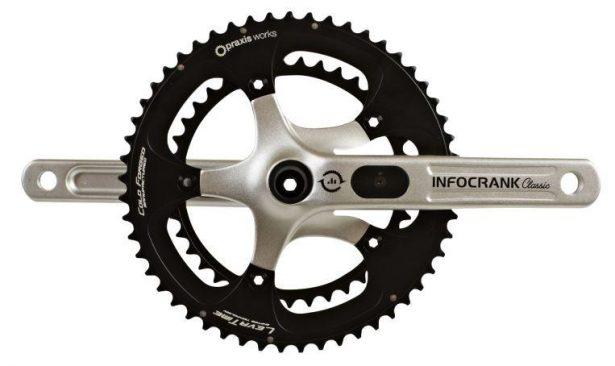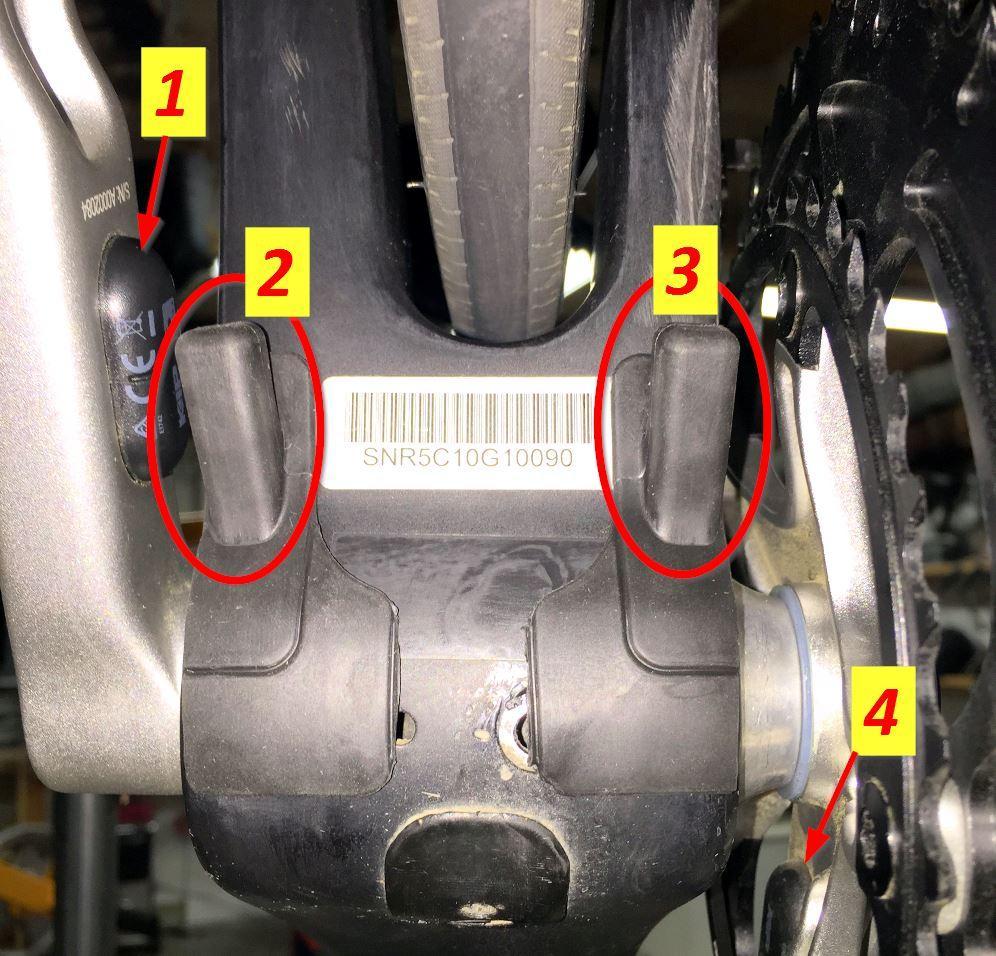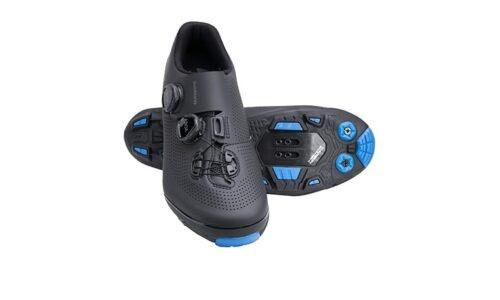Verve Cycling Infocrank
-
Overall rating
Summary
Product Category: Power Meter Crankset
Tested: InfoCrank Classic
Source: online and company website
Features: Forged crank with integrated power meter in each crankarm. Both 110mm BCD, 130 mm BCD available
How obtained: Loaned from Company
Summary: Highly accurate dual-sided power meter(s) embedded inside crank arms.
Pros
- Dual sided power reporting-both left and right crank arms
- High quality, strong stiff forged crank that has strain gauges embedded in the crank arms-reduces thickness of crank arms by 25%
- Easy installation, pairing, calibration and operation
- Worked/reported perfectly every ride
Cons
- Might have a limited audience due to fairly high price (same for all dual-sided power meters).
User Review
( votes)
WHAT IS A BICYCLE POWER METER?

A bicycling power meter is a device that measures the power output of a cyclist. Most bicycle power meters use strain gauges to measure the applied torque from the cyclist, and when combined with angular velocity, power is calculated. These are called Direct Force Power Meters and are sub-divided into single-sided and dual-sided power meters. Single-sided power meters will attach a strain gauge to either the left/non-drive side crank arm, the rear hub, or the crank. Dual-sided power meters will usually attach one strain gauge to the left crank arm and one to the right crank arm.
Some newer devices, called Non-Direct Force Power Meters (Non-DFPMs), do not use a strain gauge. Instead, they measure power through handlebar-mounted units that utilize the principles of Newton’s Third Law by measuring a cyclist’s opposing forces (gravity, wind resistance, inertia, rolling resistance) and combining these with velocity to determine the rider’s power output. Non-DFPMs are claimed by their manufacturers to be fairly accurate. By definition, these will display a single value in total watts.
CHOICES, CHOICES, CHOICES
As a USCF coach, I have been looking into the best solutions to help my clients perform at a higher level = become faster and stronger. Years ago, Heart Rate training (HRT) was all the rage, now it’s Power Based Training (PBT). This is due to the physiological consistency of power meter based training versus the inconsistency of a heart rate monitor based training system (for example, wattage output is less affected by drinking a cup of coffee before a ride than heart rate is). After explaining this to my clients, most would prefer to train using a power meter, despite the cost. Nearly every time I am asked the question, “Since the single-sided power meter is half the price, shouldn’t I get that one?”
Let me answer this in two parts.
(a)I require all of my clients to have a power meter, and,
(b)a dual-sided power meter is best.
You need an independent measurement of each leg because no one is perfectly symmetrical. Everyone has a dominant leg and a weaker leg. Single-sided power meters double the computed value and report that as total power. The problem is that by just doubling the power of one leg, you could actually be training in the wrong zone (range). In other words, you could be training too hard or not hard enough. Plus, factor in the random + or – 2% and you could easily have a huge range of error.
It is extremely important to know your left/right imbalances and work on them (or at least understand them). This can often be a reason to get a bike fit and/or aid in some functional training.
CAN’T I JUST USE A HEART RATE MONITOR?
Joe Friel describes the advantages of Power Based Training (PBT) over Heart Rate Training (HRT) the best. The following is a summary from one of his 2012 blogs – Why You Need a Power Meter. Click on this link to view Joe Friel’s whole blog.
Joe answers a users question – so why should you get a power meter?
“The short answer is that you simply are more likely to achieve your race goals by training—and racing—with a power meter than without. It is the most effective tool you can get to go faster on a bike.
Here’s Why
Input data such as heart rate isn’t meaningful until it is compared with some measure of output. Output is critical to success; input isn’t. After all, they don’t give awards at races to those who worked the hardest or had the highest heart  rates (input), but rather to those who had the fastest time which results from high power (output).
rates (input), but rather to those who had the fastest time which results from high power (output).
So should you buy a power meter or fast wheels? Given the choice I’d recommend a power meter every time. When it comes to speed, the engine is always the most important part. A power meter will help you develop a bigger one. With sleek wheels you still have a small engine.
How do they make your engine bigger? Power meters remove most of the guesswork that goes into training and racing. You get the intensity correct immediately with no guesswork. Intervals don’t taper off near the ends any more either. This means no wasted training time and precise intensity.
Also, realize that you’re not trying to train the heart solely when doing intervals or any workout. In fact, what happens in the muscles during workouts, not the heart, is really the key to your success. Heart rate monitors, while quite valuable to training, have many believing that training is just about the heart. It isn’t. Power meters allow you to focus more on muscle.
So start setting aside a few bucks a week so that some day you can get one. It will definitely change how well you train and race.”
Many people actually use both HRT and PBT to make gains, but, be aware that there are several downsides to HRT when using alone. If you want to use only one, pick PBT since there are many advantages to PBT over HRT alone.

BASIC BICYCLE POWER METER TYPES
There are 5 basic power meter attachment solutions for the bicycle. These are

In the examples above, each type has their advantages as well as disadvantages. You will need to do your homework, or wait for more BikeTestReviews to come in order to see which one is best for your overall needs, specifically functionality/usability vs cost.
*A SPIDER-BASED POWER METER (PM) VS SINGLE-SIDED
Measuring at the spider you are measuring both sides, it is different to the one side only systems. One sided Power Meters (PM’s) can only assume perfect L/R balance and double.
The spider measures the load in the system after the confluence of the loads (there are 6 whole only 1 actually propels the bike forward and is the only one worth measuring, the rest are just noise) being introduced on each side. By making an assumption that those loads are introduced symmetrically at each stroke (between 12:00 and 6:00) power can be attributed to each leg. The simplest case they assume a 50/50 balance.
whole only 1 actually propels the bike forward and is the only one worth measuring, the rest are just noise) being introduced on each side. By making an assumption that those loads are introduced symmetrically at each stroke (between 12:00 and 6:00) power can be attributed to each leg. The simplest case they assume a 50/50 balance.
A spider based system can measure torque and attribute the value it measures to a side based on a fixed half a cycle (12:00 to 6:00) then some assumptions on balance can be made. For example if the power for the full cycle was 250 watts but for the first half where the L crank was travelling from 12:00 to 6:00 position the torque was equivalent to a power of 150W and the second half where the R crank was travelling from 12:00 to 6:00 the torque measured was equivalent to a power of 100W then the balance would result in 60%L/40%R.
As Kautz and Hull showed in 1993, the forces applied to the pedal (via the crank) change in intensity and direction all through the pedal stroke and do not fit into a neat 12 o’clock or 6 o’clock concept. Not only does the force change during the pedal stroke but it changes comparatively depending on cadence. Then it also changes depending on each leg.
It’s not hard to see how this would be very inaccurate. Just the assumption that each leg stops and starts contributing to the full circle at precisely 12:00 and 6:00 is clearly wrong.
It cannot be used for any pedal stroke analysis as it assumes there can be no lifting load from the dragging leg. It assumes no drag from the dragging leg. It’s as if you unclip the rising leg from 6:00 to 12:00 in the pedal stroke.

Spider based systems might be able to use algorithms (technically guesses) to adjust the strict 12:00 to 6:00 portion they could also assume a small portion of drag from the rising leg and fiddle some numbers to make it look more ‘natural’ but those assumptions would then apply to all users regardless of their true balance and pedal action.
It is worth remembering that an algorithm is used to manipulate measured data in such a way as to render the results useful within a certain range.
A calculation is used to take two or more measured data and provide a precise result.
InfoCrank does not require an algorithm to manipulate our measured torque or cadence data we calculate power from the two metrics required to calculate it measured directly.
Table 3 below describes several of the advantages vs disadvantages.
The final piece of equipment you will need is either a bike computer that supports power recordings (CycleOps, Powertap, o_synce), or a full blown GPS head unit (Garmin, Magellan) which also supports the recording of power output as well as Shimano Di2 data. Make sure that you choose one that supports your specific power meter choice. For example, if you choose a dual-sided power meter, you will need to choose a head unit that supports both left/right readings and display as well as zones. As of this writing, Garmin Edge 510, 810, 1000 and both Pioneer cycle computers SGX-CA500 and SGX-CA900 support this feature.
which also supports the recording of power output as well as Shimano Di2 data. Make sure that you choose one that supports your specific power meter choice. For example, if you choose a dual-sided power meter, you will need to choose a head unit that supports both left/right readings and display as well as zones. As of this writing, Garmin Edge 510, 810, 1000 and both Pioneer cycle computers SGX-CA500 and SGX-CA900 support this feature.

* One item to look at before you buy is spacing.
The test bike chosen for this review was the Cervelo R5ca. I wanted to use this bike for a worst-case spacing scenario. The R5ca uses the BBRight bottom bracket as well as thicker chain stays which means that there is very little room between the inside of the crank arm and outside of the chain stays… so little room in fact that the Pioneer’s actually hits the R5ca’s left chain stay during each revolution! When I called Pioneer support, the only thing they could offer was suggesting that I add spacers between each crank arm and Bottom Bracket (BB) shell. This would hopefully push the crank arms out far enough so that the strain gauges would not hit the chain stays.
this bike for a worst-case spacing scenario. The R5ca uses the BBRight bottom bracket as well as thicker chain stays which means that there is very little room between the inside of the crank arm and outside of the chain stays… so little room in fact that the Pioneer’s actually hits the R5ca’s left chain stay during each revolution! When I called Pioneer support, the only thing they could offer was suggesting that I add spacers between each crank arm and Bottom Bracket (BB) shell. This would hopefully push the crank arms out far enough so that the strain gauges would not hit the chain stays.
Spacer Limitations: My normal cranksets are the Shimano Dura-Ace FC-9000 and the Ultegra FC-6800. In order to keep the number of spacers to a minimum, Shimano has included a ‘plate’ that snaps into a recessed area of the crank spindle. If you add too many spacers, the plate will not snap into the hole. This is used in order so that there is enough spindle for the left crank arm to grab onto. For a Stages power meter, I was able to add 2mm of spacer to the left crank arm, safely clearing the chain stay. For the Pioneer, it was still too tight. 2mm was the maximum allowed by the Shimano ‘plate’. More on this in my next review of the Stages.
INTRODUCING THE VERVE CYCLING INFOCRANK !
-Verve Cycling designed InfoCrank to be highly accurate, easy to use, tough and robust. With a forged crank,  it’s built for a lifetime of use.
it’s built for a lifetime of use.
-InfoCrank is a new generation of cycle power meter. Compared to other power meters, one big difference is that InfoCrank’s power meter functionality is integrated/embedded into the crank arms.
-Selling an old frame and getting a new one? No problem. Just pull off the InfoCrank and quickly re-install on the new bike. They come in either 24mm spindle or 30 mm spindle sizes.
-The first thing to do after opening the InfoCrank box is to hold the left crank arm up to the bike. IT FITS!!! If it will fit the R5ca, it will fit just about every other bike (well maybe not the Look Zed2 BB, but that’s a whole ‘nuther issue that has to do with their HUGE one-off 6810 BB).
DESIGN
The InfoCrank crankset was designed as a new product, not as a strain gauge glued onto an existing crank arm. What this new design gives us is full bilateral power measurement whose mechanics and electronics are embedded inside ultra-stiff forged crank arms which allow the best load path from the pedals all the way to the bottom bracket.
bottom bracket.
Embedding the power meter inside of the crank arms not only allows for a narrower profile but doesn’t loose anything on styling – they really look good. Chainring options are currently by Praxis and, so far, they have been rock solid. Both 110BCD and 130BCD cranks are available so you can use any of your preferred rings as well, including Rotor.
Each crank arm has both an inner and outer recess cut into it. The outer recess houses the battery and electronics while the inner recess houses the power-meter module. Each crank arm requires 2 x SR44 silver oxide batteries (357 in the USA), are easily accessed and can be quickly changed. You can expect to get around 500 hours of use out of a fresh set of batteries. That’s about a year of doing 3 hours per day, 4 days a week. But, make sure that any replacement batteries say SR44, not LR44. A 10-pack of 375/SR44 batteries on Amazon will set up back about $10.50.
InfoCrank’s power-measurement modules run at a high sampling rate. They produce a clean, accurate, and dependable data stream from each crank that’s transmitted via the ANT+ wireless protocol to a head unit of your choice. You get an accurate, real-time display of the power produced by each leg. These power values are updated to the head unit each pedal rotation.
CALIBRATE
One-time calibration is required, but it is super easy. Just place the crank arms vertical – make sure that the bike is upright and not moving and no weight on the pedals. Click the ‘calibrate’ button on your head unit and less than 2 seconds later, you’re done!
HOW DID THEY WORK FOR ME?
 Opening the box, everything was included. Full crankset, chainrings, head unit, two sets of cadence magnets and some miscellaneous cables, bits and pieces.
Opening the box, everything was included. Full crankset, chainrings, head unit, two sets of cadence magnets and some miscellaneous cables, bits and pieces.
Aaron Hoekstra, Customer Service Coordinator for Verve Cycling texted me and asked that I give him a call when the crank arrived. There were only a couple items that we needed to walk through and the installation was very straight forward. After removing my Dura-Ace 9000 crankset, I pushed the InfoCrank through the Cervelo’s BBRight bottom bracket. After tightening the non-drive side crankarm bolt, the crank wobbled. The crankset uses a splined crankarm similar to the ISIS one pictured above. The crankarm prematurely bottomed out on the shoulder stops. Luckily there were several spacers included. You can see in the photo to the right, a translucent white spacer on the drive side of the crankset. This did the trick. By adding a single spacer, the crankset fit snug. No wobble, no play, and, most importantly, no drag.
the shoulder stops. Luckily there were several spacers included. You can see in the photo to the right, a translucent white spacer on the drive side of the crankset. This did the trick. By adding a single spacer, the crankset fit snug. No wobble, no play, and, most importantly, no drag.
Next, it was time to install the cadence magnets. As stated earlier, a Praxis bottom bracket is recommended for use by Verve Cycling since the magnets are easily slipped onto the cups and secured by set screws. The R5ca uses a direct fit BB design so I am forced to stay with the standard 30x42x7 (6806) BB30 bearings plus BBRight spacers. This also means that I need to use the other cadence magnet option that comes in the accessories pack. This second set of magnets (shown below to the right) uses a 3M  adhesive that you unpeel and stick to the underside of the BB shell. As you can see in the picture above, in order for it to fit and work correctly, I had to cut it in half as well as trim the sides so that the magnets would sit outboard as much as possible. In the picture above, #1 and #4 are the
adhesive that you unpeel and stick to the underside of the BB shell. As you can see in the picture above, in order for it to fit and work correctly, I had to cut it in half as well as trim the sides so that the magnets would sit outboard as much as possible. In the picture above, #1 and #4 are the  cadence sensors embedded into the crank arms, #2, #3 are the magnets. The key is to get the magnets as close to the sensors as possible, mark the outline of the magnets, unpeel the tape then stick. A quick check by spinning the cranks and watching the green lights flash told me everything was installed and working correctly. Next, I checked the torque on the chainring bolts followed by pairing the Power Meter to my
cadence sensors embedded into the crank arms, #2, #3 are the magnets. The key is to get the magnets as close to the sensors as possible, mark the outline of the magnets, unpeel the tape then stick. A quick check by spinning the cranks and watching the green lights flash told me everything was installed and working correctly. Next, I checked the torque on the chainring bolts followed by pairing the Power Meter to my  GPS head unit. Lastly, I calibrated the power meter. A quick spin around the block showed me that everything was working perfectly.
GPS head unit. Lastly, I calibrated the power meter. A quick spin around the block showed me that everything was working perfectly.
The installation could not have been easier!
After a dozen rides, the unit still starts right up with the first spin of the pedals and records perfectly.
The following is the power profile from a recent ride … note that my GPS head unit does not yet have the dual power reporting firmware yet. The manufacturer promises that it will be in the next update. When it does, there will be a left and right power noted. The graph below was generated by the Golden Cheetah Cycling Power Analysis Program.
The InfoCrank is a clean, modern crankset engineered with quality materials and workmanship. It’s built rugged and has been rock-solid! USA made strain gauges are embedded into the crank arms and the unit delivers bilateral power measurement and reporting to the head unit. It is ANT+ bike computer compatible, it compensates for ambient temperature (i.e., no drift), is IPX7 waterproof compliant (immersion under water at a depth of 1 meter [3.28 feet or 39.37 inches] for 30 minutes) and it’s factory-calibrated for life!
When riding with Verve Cycling’s InfoCrank, you have the essential foundation for getting better on the bike quicker than with any other type of training aid.
RECOMMENDATION
HIGHLY RECOMMENDED! Yes, the InfoCrank is really that good. When riding/racing/training, you will find yourself looking at your Power Output a lot more. Couple that with working with a good coach and you will see significant improvements very quickly!




I have always enjoyed bicycling and, through a series of coincidences, became a Bicycle Industry Consultant and Product Tester. I test prototype products for companies and have published only off the shelf production products on biketestreviews.com.



